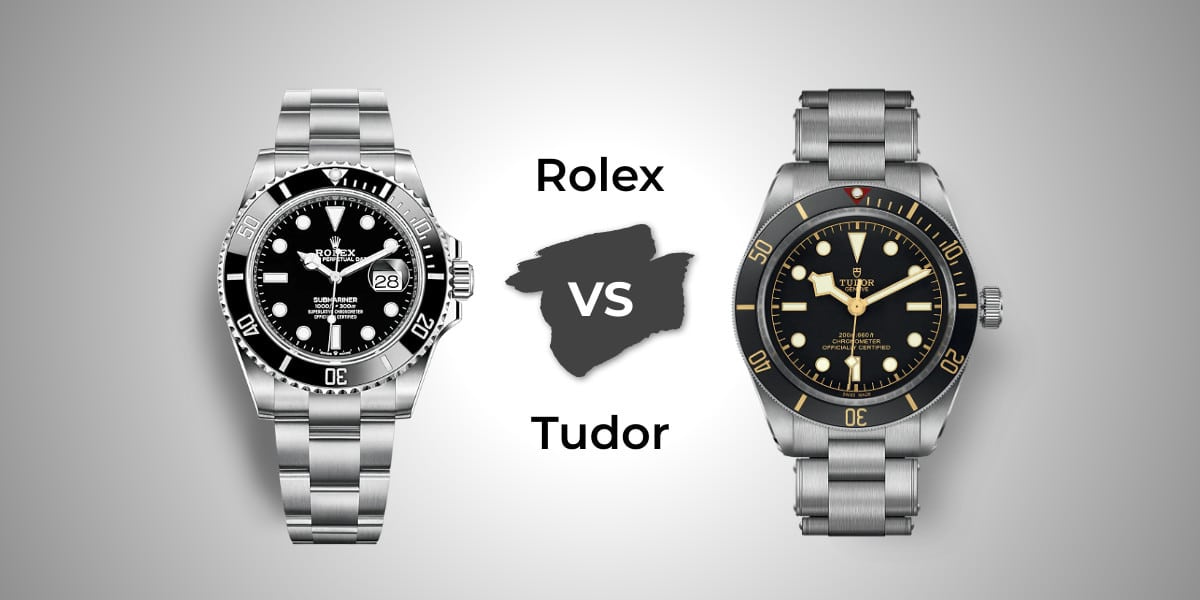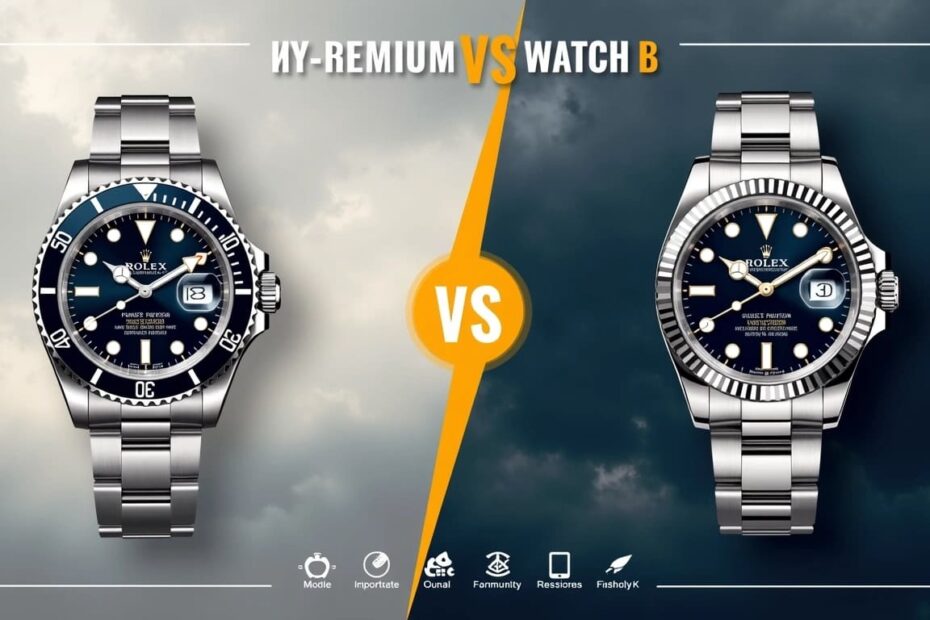Introduction
When it comes to luxury watches, Tudor vs Rolex is a debate that many watch enthusiasts have engaged in for years. Both brands are part of the same Swiss watchmaking heritage, yet they each bring their unique appeal and characteristics to the table.
Tudor offers luxury watches at a more accessible price point, while Rolex is widely considered one of the most prestigious names in the watch world.
This article will compare both brands to help luxury watch buyers decide which one is the right fit for them.
The History Behind Tudor vs Rolex

Both Tudor and Rolex were founded by Hans Wilsdorf, a visionary in the Swiss watch industry. Rolex, founded in 1905, quickly became synonymous with high-end, reliable timepieces.
Wilsdorf founded Tudor in 1926 as a more affordable alternative to Rolex, offering similar high-quality craftsmanship but at a lower price point.
Despite their shared history, the two brands have followed different paths in terms of branding, pricing, and market appeal.
Rolex has cemented its place as one of the most recognizable and expensive luxury watch brands in the world. Tudor, on the other hand, has always targeted a slightly younger and more price-conscious audience without compromising on the quality associated with its parent company.
Design and Aesthetics: Tudor vs Rolex
When comparing Tudor vs Rolex, one of the most noticeable differences is their design and aesthetics.
Rolex watches are known for their timeless, classic designs. They are often simple, elegant, and instantly recognizable due to their distinctive look.
The famous Oyster case, used in many Rolex models, has become an icon in the world of luxury watches. Rolex watches typically use clean, polished metal finishes and feature understated dials.
Tudor, in comparison, offers slightly more modern, adventurous designs, often with a sportier edge. For example, Tudor’s Black Bay collection is known for its bold, vintage-inspired designs with prominent lugs, thick bezels, and strong, bold color schemes. Tudor’s dive watches, in particular, stand out with their robust, industrial look.
While Rolex tends to keep things more classic and refined, Tudor is a great option for those who enjoy a more contemporary, yet still luxurious, aesthetic.
In the Tudor vs Rolex design debate, it all comes down to personal preference. Do you prefer the understated elegance of Rolex or the bold, adventurous style of Tudor?
Build Quality and Materials of Tudor vs Rolex

Both brands are renowned for their exceptional build quality, but Rolex is often seen as a leader in this area. The brand uses top-tier materials, including 904L stainless steel, which is highly resistant to corrosion.
Rolex also uses gold alloys, including 18k yellow, white, and Everose gold, ensuring that their watches are both durable and luxurious.
Tudor, while still using high-quality materials, generally opts for 316L stainless steel, which is a bit more common and less resistant to corrosion than Rolex’s 904L steel.
Tudor does, however, use some premium materials like titanium in certain models, offering a lighter and more durable alternative.
In terms of overall build quality, Rolex takes the lead, especially when considering the rigorous standards to which each piece is held. Tudor, however, offers comparable craftsmanship and durability for a more budget-conscious price.
Movements and Technology of Tudor vs Rolex
When comparing the movements inside Tudor vs Rolex watches, it’s important to recognize the difference in terms of performance and innovation.
Rolex has a long history of creating in-house movements that are highly accurate and reliable. Rolex’s movements are COSC-certified (Swiss Official Chronometer Testing Institute), meaning they pass stringent tests for precision.
Some of the standout Rolex movements, such as the Caliber 3135, are known for their robustness and longevity.
Rolex also implements its proprietary Parachrom hairspring, which makes its movements more resistant to shocks and temperature changes.
On the other hand, Tudor also uses high-quality movements, but they often rely on movements from external suppliers.
For example, many Tudor watches are powered by movements from ETA or Sellita. While these movements are highly reliable, they don’t have the same level of prestige as the in-house movements found in Rolex watches.
However, Tudor has recently begun incorporating in-house movements in some of their models, such as the Tudor Caliber MT5612, which has received positive reviews for its performance and accuracy.
While Rolex leads in terms of movement technology and exclusivity, Tudor offers impressive movements at a more affordable price point. It all depends on how much importance you place on the brand’s in-house movements versus performance.
Pricing of Tudor vs Rolex
One of the most significant differences when it comes to Tudor vs Rolex is the price. Rolex watches are known for their high prices, with many models costing several thousand dollars. Prices can range from $5,000 to well over $100,000 for limited-edition or precious metal models.
Tudor, in comparison, is far more accessible. While still considered a luxury brand, Tudor offers watches starting at around $2,000, with most models falling between $2,500 and $5,000. This makes Tudor an excellent option for those who want a high-quality, luxury watch but are looking for something more budget-friendly than a Rolex.
While Rolex is undeniably more expensive, it also holds its value better over time. Many Rolex watches appreciate, especially limited-edition models, which can be seen as an investment. Tudor, while excellent in quality, generally doesn’t have the same resale value as Rolex, although it still holds its value relatively well.
Durability and Longevity of Tudor vs Rolex
When it comes to durability and longevity, both brands are known for their high standards of craftsmanship. Rolex is renowned for creating watches that can withstand years of wear and tear. The brand’s Oyster case, along with its robust materials and in-house movements, ensures that Rolex watches can endure the test of time.
Tudor, while also durable, may not quite match the longevity of a Rolex in terms of long-term wear. Tudor watches are built to last and are great for daily wear, but Rolex is often seen as a timepiece that can last a lifetime and beyond, potentially becoming an heirloom passed down through generations.
In terms of durability, Rolex generally wins, but Tudor is still a great option for those who want a reliable, long-lasting timepiece without the steep price tag.
Conclusion
In the debate of Tudor vs Rolex, the right choice ultimately depends on what you are looking for in a luxury watch.
Rolex is the epitome of prestige and exclusivity. It is a watch that holds its value, offers top-notch technology, and is recognized worldwide as a symbol of success.
If you’re willing to invest more money for the ultimate luxury watch experience, Rolex is the obvious choice.
However, Tudor is an excellent alternative for those who want a high-quality, durable timepiece without the astronomical price tag. With its modern designs and robust movements, Tudor offers great value for money, making it an appealing choice for luxury watch buyers who want to make a statement without breaking the bank.
In the end, both Tudor vs Rolex offer exceptional watches. The decision comes down to budget, design preferences, and how much you value brand prestige.
Whichever you choose, you’re guaranteed a quality timepiece that will stand the test of time.
